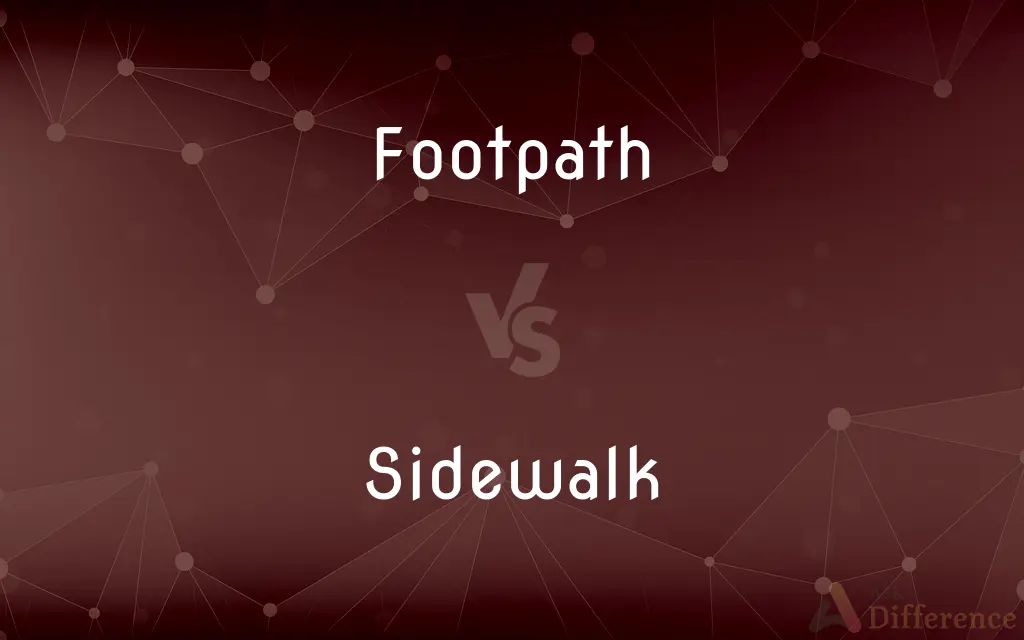Footpath vs. Sidewalk — What's the Difference?
By Maham Liaqat & Urooj Arif — Updated on April 4, 2024
A footpath is often a rural or natural path for walking, while a sidewalk is a paved path alongside a street in urban areas.

Difference Between Footpath and Sidewalk
Table of Contents
ADVERTISEMENT
Key Differences
Footpaths are typically found in less urbanized areas, providing a natural or dirt path for pedestrians, often through parks or countryside. These paths cater to recreational or scenic walks. On the other hand, sidewalks are constructed paths adjacent to roads in urban and suburban areas, designed for pedestrian safety and mobility, made from concrete or asphalt.
While footpaths offer a more natural walking experience, often surrounded by vegetation or natural landscapes, sidewalks are engineered for pedestrian traffic in developed areas, ensuring a smooth, level surface for walking, accessibility, and convenience. Whereas footpaths might navigate through uneven terrains, including hills and valleys, sidewalks are usually flat and even, accommodating a wide range of pedestrians, including those with mobility aids.
Footpaths emphasize connectivity with nature, providing routes that might cross streams, forests, and fields, enhancing the walking experience with scenic views and tranquility. Sidewalks, in contrast, prioritize connectivity within urban infrastructure, facilitating access to commercial, residential, and public spaces while ensuring pedestrian safety alongside vehicular roads.
In terms of maintenance, footpaths require regular checks to ensure they are passable and safe, with concerns often related to natural wear and weather effects. Sidewalks, however, involve more systematic maintenance by municipal authorities, addressing issues like cracks, uneven surfaces, and accessibility to maintain a safe walking environment.
Accessibility varies significantly between the two, with footpaths sometimes presenting challenges for individuals with disabilities due to natural obstacles or uneven surfaces. Sidewalks are designed with accessibility in mind, incorporating features like curb cuts, tactile paving, and ramps to support individuals with disabilities, ensuring inclusivity in urban pedestrian infrastructure.
ADVERTISEMENT
Comparison Chart
Location
Rural or natural areas
Urban and suburban areas
Surface
Natural, possibly uneven
Paved, typically concrete or asphalt, and even
Purpose
Recreational, scenic walks
Safety, mobility alongside roads
Maintenance
Managed for passability and safety, affected by nature
Systematically maintained for safety and accessibility
Accessibility
May have natural barriers, not always accessible
Designed for accessibility, including ramps and cuts
Compare with Definitions
Footpath
A trail marked for hiking or walking in nature.
They followed the footpath up the mountain for breathtaking views.
Sidewalk
A paved path for pedestrians alongside a street in urban areas.
They strolled down the sidewalk, window-shopping along the way.
Footpath
A narrow path for walking in rural or natural areas.
The footpath through the woods leads to a hidden lake.
Sidewalk
A concrete or asphalt pathway for safe pedestrian use in cities.
The city council approved the construction of wider sidewalks.
Footpath
A path in a park designed for pedestrian use.
The park's footpath winds through various botanical gardens.
Sidewalk
A designated pedestrian area next to urban roads.
The children rode their scooters on the sidewalk, away from the traffic.
Footpath
An unpaved trail for pedestrians in natural settings.
The footpath through the meadow is popular with morning walkers.
Sidewalk
A walkway providing accessibility and safety in developed areas.
The new sidewalks have curb cuts for wheelchair access.
Footpath
A rural walking track not adjacent to roads.
The village is connected by a network of footpaths.
Sidewalk
An urban path separate from the roadway for pedestrians.
Outdoor cafes extend onto the sidewalk during summer.
Footpath
A footpath (also pedestrian way, walking trail, nature trail) is a type of thoroughfare that is intended for use only by pedestrians and not other forms of traffic such as motorized vehicles, cycles, and horses. They can be found in a wide variety of places, from the centre of cities, to farmland, to mountain ridges.
Sidewalk
A sidewalk (North American English), pavement (British English), footpath (Oceanian English), or footway, is a path along the side of a road. Usually constructed of concrete or asphalt, it is designed for pedestrians.
Footpath
A narrow path for persons on foot.
Sidewalk
A paved walkway along the side of a street.
Footpath
Any set path or trail to be used by people walking.
Sidewalk
(US) (usually) a paved footpath located at the side of a road, for the use of pedestrians
Footpath
A paved path located at the side of a road for the use of pedestrians.
Sidewalk
Any paved footpath, even if not located at the side of a road
Footpath
A narrow path or way for pedestrains only; a footway.
Sidewalk
A walk for foot passengers at the side of a street or road; a foot pavement.
Footpath
A trodden path
Sidewalk
Walk consisting of a paved area for pedestrians; usually beside a street or roadway
Common Curiosities
Do sidewalks contribute to urban accessibility?
Absolutely, sidewalks are crucial for urban accessibility, facilitating pedestrian movement and accommodating those with mobility aids.
Can bicycles be used on a footpath?
It depends on local regulations, but footpaths are generally intended for pedestrian use and might not accommodate bicycles well.
Are sidewalks safer than walking on the road?
Yes, sidewalks provide a designated space for pedestrians, significantly reducing the risk of accidents with vehicles.
Are pets allowed on sidewalks?
Generally, pets are allowed on sidewalks if they are on a leash, though specific rules can vary by location.
Can footpaths connect between villages or towns?
Yes, footpaths can serve as scenic routes connecting villages, towns, or points of interest in less urbanized areas.
Do sidewalks need to comply with specific regulations?
Sidewalks must comply with regulations regarding width, slope, and accessibility features to meet safety and accessibility standards.
Are footpaths suitable for all types of weather?
Footpaths can be affected by weather conditions, making them challenging to use during heavy rain, snow, or other adverse weather.
How are sidewalks maintained?
Municipalities or local government bodies are responsible for the maintenance of sidewalks, addressing issues like cracks, potholes, and ensuring accessibility.
Do footpaths have lighting for evening walks?
Many footpaths do not have lighting, making them less suitable for use after dark compared to well-lit urban sidewalks.
Is it common for footpaths to cross private land?
In some regions, footpaths may cross private land, but public right-of-way laws allow their use by pedestrians.
Are footpaths and sidewalks legally protected for pedestrian use?
Yes, both are protected under various laws and regulations to ensure pedestrian safety and access, though the specifics can vary by jurisdiction.
Can footpaths be used for running or jogging?
Yes, footpaths are popular among runners and joggers, especially for those seeking a scenic or natural environment for their exercise.
How do urban planners integrate sidewalks into cityscapes?
Urban planners integrate sidewalks into city designs to enhance pedestrian connectivity, safety, and urban aesthetics, often incorporating greenery and public art.
What makes a sidewalk accessible to wheelchair users?
Features like curb cuts, smooth surfaces, wide paths, and ramps make sidewalks accessible to wheelchair users.
Can footpaths be paved?
While typically natural, some footpaths may be paved in areas where erosion or heavy use necessitates a more durable surface.
Share Your Discovery

Previous Comparison
Crew vs. Staff
Next Comparison
Gangster vs. ThugAuthor Spotlight
Written by
Maham LiaqatCo-written by
Urooj ArifUrooj is a skilled content writer at Ask Difference, known for her exceptional ability to simplify complex topics into engaging and informative content. With a passion for research and a flair for clear, concise writing, she consistently delivers articles that resonate with our diverse audience.
















































